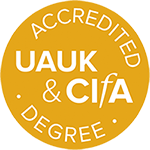The Geography of Knowledge in Assyria and Babylonia: A Diachronic Analysis of Four Scholarly Libraries
Where is knowledge generated? How does that knowledge replicate and spread? Where is it consumed? Who owns knowledge, and who may access it? Under what circumstances, and in what places, does it flourish or die out? How are its transmission and reception influenced by social and political factors? These are central questions in the history and sociology of science today. However, they have never been asked of Assyria or Babylonia in the first millennium BCE.
Early in that millennium, Assyria was by far the most powerful empire of the Mediterranean and Middle East. The ideology of empire centred on the symbiotic relationship between the king and the great god Aššur: military conquest was both an act of devotion and confirmation of Aššur's support. But Assyrian kingship depended not solely on piety and military might. A retinue of scholarly advisors guided royal decision-making through the observation and analysis of omens, and the performance of appropriate rituals. The scholars in turn depended on large libraries holding a wide range of scholarly works written on cuneiform tablets, from astronomy to mythology, kept both in private households and in institutions such as temples and palaces.
After Assyria fell in 612 BCE, Babylonian scholarly activity continued to flourish and develop under the patronage of wealthy urban temples in the south. Here scholarship was adapted to new purposes of maintaining the intellectual integrity and social status of native religion in the face of new ways of thinking and believing. The courts of Iranian (c.540-330 BCE; c.130 BCE onwards) and Greek (c.330-130 BCE) rulers no longer supported cuneiform scholarly traditions. New genres came into being; others were adapted or survived relatively unchanged; still others disappeared completely. Temples were the last bastions of cuneiform scholarship until at least the final centuries BCE.
A diachronic analysis of four scholarly libraries
While many hundreds of individual scholarly works have been edited and published from cuneiform libraries, there have been almost no in-depth studies of the libraries in their entirety. Previous analyses have often decontextualised and fragmented Assyro-Babylonian scholarship into modern disciplinary categories such as 'science', 'magic', and 'religion'. This project aims to restore context and coherence to that scholarship by studying it holistically.
To that end we are undertaking a comparative study of four scholarly libraries for which adequate archaeological data exist:
- the Neo-Assyrian temple library of Nabû in the royal city of Nimrud/Kalhu in northern Iraq (Wiseman and Black, Cuneiform Texts from Nimrud, 4 [1996]);
- the library found outside a priestly family house in Sultantepe/Huzirina near Harran, at the edge of the Neo-Assyrian empire (Gurney and Finkelstein, Gurney and Hulin, Sultantepe Tablets, 1-2 [1957, 1964]), destroyed, like the temple library, in c.612 BCE;
- the library from a private house from area Ue 18 in Uruk, owned by two separate families of āšipu scholars, c.450-300 BCE (Hunger, von Weiher, Spätbabylonische Texte aus Uruk, 1-5 [1976-1998]);
- the library of Rēš, temple of the great sky god Anu-Zeus in Uruk, c.200 BCE (van Dijk and Mayer, Baghdader Mitteilungen, Beiheft 10 [1983] and related, informally excavated tablets).
Later in the project, we will make quantitative analyses of the manuscripts' linguistic and orthographic features to look for small-scale and large-scale geographical and diachronic change. We will use methodology from the history of science to explain those continuities, changes, and idiosyncracies in relation to the social, intellectual, and political contexts in which the scholars were working.
The Corpus of Ancient Mesopotamian Scholarship
The project is using open, standards-based encoding to create the Corpus of Ancient Mesopotamian Scholarship (CAMS), following Open Richly-Annotated Cuneiform Corpus (ORACC) and Cuneiform Digital Library Initiative specifications. This freely available, online corpus of material from the four libraries is being critically edited according to Assyriological best practice, based on collation of the original tablets wherever possible. It contains searchable transliterations of both manuscripts (tablets) and compositions (composite texts) as well as English translations and full bibliographies.
One of the advantages of web-based edition is that revisions and improvements are easy to implement. The project thus has a policy of publishing its editorial work promptly, returning later to revise transliterations and translations as necessary. Please remember, then, that the contents of CAMS are to some extent provisional, often updated, and always subject to change until the end of the project in 2012.
- Marie-Françoise Besnier (HPS, Cambridge), full-time researcher
- Philippe Clancier (HPS, Cambridge), full-time researcher (from 1.ix.2007 to 31.viii.2009)
- Graham Cunningham (HPS, Cambridge), part-time senior researcher
- Ruth Horry (HPS, Cambridge), website consultant
- Frances Reynolds, part-time researcher (from 1.ix.2007 to 31.x.2008)
- Eleanor Robson (HPS, Cambridge), co-director
- Kathryn Stevens (Classics, Cambridge), research assistant
- Steve Tinney (Penn Museum, Philadelphia), co-director
- Greta Van Buylaere (HPS, Cambridge), full-time researcher



